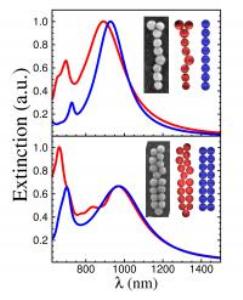Researchers at Rice University have carried out a study to highlight the similarities in plasmonics and polymer behavior that could pave the way for building smaller and better computing systems and antennae.
 Transmissiona dn extinction point of light through nanoparticles(Credit: Liane Slaughter/Rice University)
Transmissiona dn extinction point of light through nanoparticles(Credit: Liane Slaughter/Rice University)
Plastic is a perfect illustration of the way polymers formed by virtue of chemical interaction and self-assemble into patterns. The team at Rice University has endeavored to establish similar patterns formed by interaction of surface plasmons in chains of gold nanoparticles. Plasmons flow through metallic particles on excitation with a light source.
The important aspect to shrinking the size of computing devices is to equip nanoparticles with the capability to allow propagation of waves for interpreting signals. The research team therefore wanted to determine the influence exerted by plasmons on each other across gaps measuring as small as 1 nm between nanoparticles of gold. The team replicated polymer structure by synthesizing chains of gold nanoparticles measuring 50 nm in single and double rows. The team studied the sub-radiant and super-radiant light signals jointly sustained by independent nanoparticle assemblies and found that the frequency of light that the chains interacted with depended on shape, size and position of the nanoparticles. The researchers discovered that replacing a single chain with a double chain was similar to changing the atoms that recur in a polymer chain. While the latter alters polymer properties, the former alters interactions along the gold nanoparticle chain. They found evidence of differentiation between single and double plasmonic chains by way of a super-radiant mode with lower energy and extra sub-radiant modes in the double-row chains. The team observed two other intriguing aspects during their study. One was that disorder among the nanoparticles mattered only at the small scale and had no impact on the optical properties in a larger system. This is important because it is not possible to synthesize a perfect nanoparticle system where all particles are of the same size and shape. The second observation was that the change in the optical spectrum was confined only up to a specific length of the nanoparticle chain beyond which the energy of the super-radiant mode leveled off.